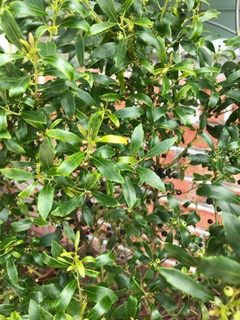Ilex glabra, commonly called Inkberry, is an up-right evergreen native to North America. This plant grows from Nova Scotia to Florida and west to Louisiana, where it is normally found in sandy woods, swamps, and bogs.
Inkberry is in the family Aquifoliales. It prefers rich, moist soil and grows best in sun to part shade. It can reach 5 – 8-feet tall and 5 – 8-feet wide. Inkberry will remain evergreen in the winter unless temperatures drop below 0 degrees Fahrenheit. Inkberry is slow-growing and is dioecious, needing both male and female plants to produce fruit. The flowers are inconspicuous but the berry-like drupes mature in the fall and remain all winter until eaten by birds. The berries are jet-black.
Inkberry is moderately salt tolerant and prefers medium to wet soil. It attracts pollinators but can be browsed by deer and bunnies. Inkberry has a high flammability rating so it should not be planted too close to the home. It is susceptible to chlorosis in soils with high pH.
Native Americans roasted Inkberry leaves to make tea. In some areas of the South, it is still called Appalachian tea. Gallberry honey is also a product of Inkberry. It is a highly-rated local honey in the South where beekeepers release bees from late April to early June while Inkberry is flowering. www.missouribotanicalgarden.org
Inkberry is a larval host plant for Henry’s Elfin (Callophyys henrici) larvae which appear from February to May and have one flight. Adult Henry’s Elfin butterflies feed on flower nectar. Other adult butterflies and bees are attracted to the blossoms. Members of the genus Ilexsupport the specialized bee Colletes banksi. www.plants.ces.NCSU.edu
Inkberry is at home in wetlands, rain gardens or woodland gardens. It is best used as an informal hedge and can be found in the Sunny Native Garden of the Brunswick County Botanical Garden.

Information and Photos by Jeanne Pavero
